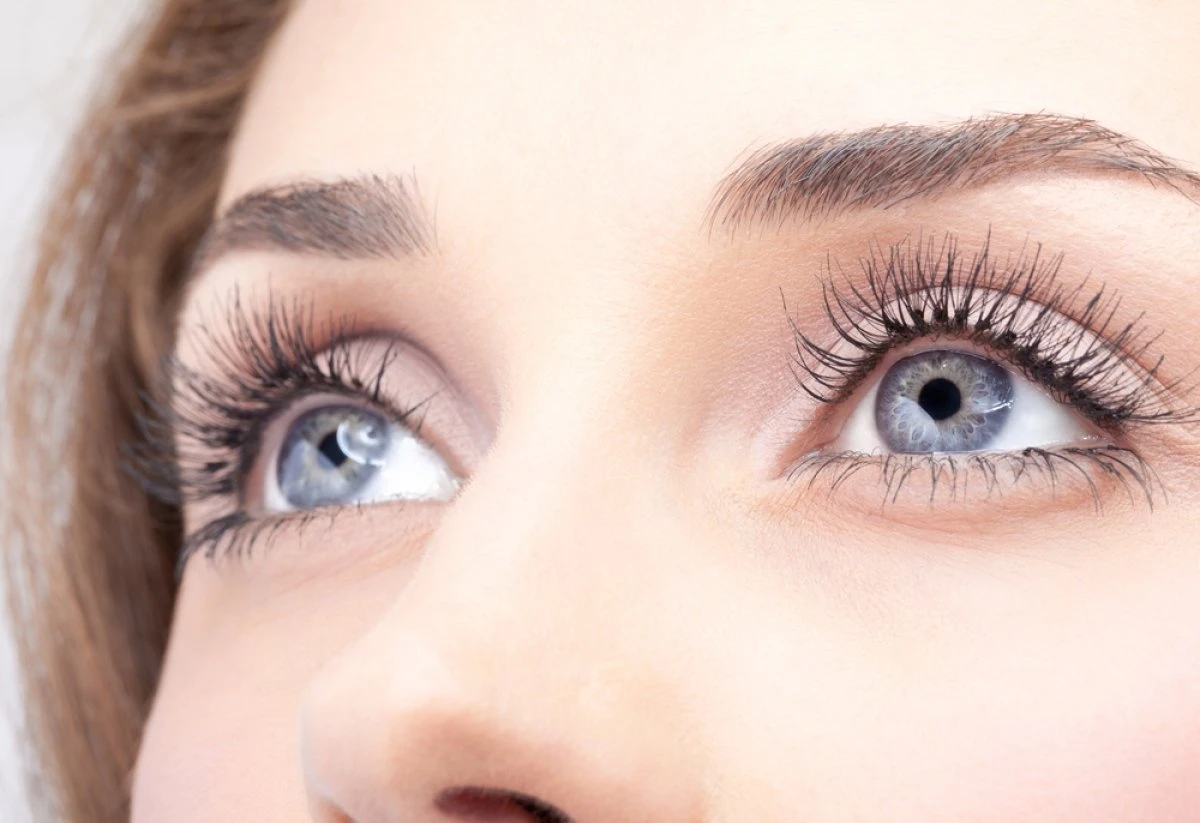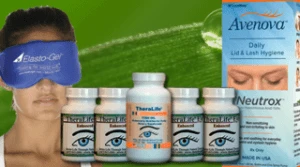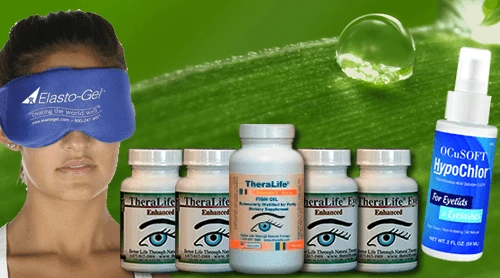If you experience swollen eyelids, a cold compress applied for 10–15 minutes can help reduce swelling. For added anti-inflammatory and soothing effects, try placing cooled chamomile tea bags or refrigerated cucumber slices over your closed eyes. While aloe vera is sometimes used for skin relief, it lacks solid clinical evidence—conduct a patch test first. Avoid turmeric paste due to potential irritation. Persistent or severe swelling should be evaluated medically.
Theralife’s range of products offers significant benefits for those dealing with eye conditions. Their comprehensive approach addresses various eye health concerns, providing relief and improving overall eye wellness. Through their specialized formulations, Theralife products help manage symptoms associated with conditions like blepharitis, dry eyes, and other inflammatory eye issues. By leveraging natural ingredients and clinically-backed strategies, Theralife enhances the quality of life for its users, ensuring both efficacy and safety.
Eyelid Swollen Due To Blepharitis and Dry Eyes- When Drops Don’t Work.
Treat the underlying cause of swollen eyelids due to blepharitis, chalazion or styes with TheraLife.
Relief your dry eyes to prevent recurrence. Make more tears naturally with an oral formula that works.
Key Takeaways
- Apply a cold compress for 10–15 minutes to reduce swelling and promote drainage.
- Use chilled cucumber slices on closed eyes to quickly soothe and hydrate puffy eyelids.
- Try cooled chamomile tea bags over eyelids for their natural anti-inflammatory and calming effects.
- Avoid direct eye rubbing and opt for gentle massage or warm compresses to improve drainage.
- Always seek medical evaluation if swelling is severe, persistent, or accompanied by vision changes.
Cold Compress Therapy
Cold compress therapy remains one of the most frequently recommended initial interventions for swollen eyelids. When you apply a compress soaked in cold water to the affected area, vasoconstriction occurs, which reduces capillary blood flow and thereby minimizes swelling and discomfort. Ascertain the compress is clean, and always use cold water to optimize the anti-inflammatory effect. You should gently press the compress against your closed eyelid for 10–15 minutes, repeating as necessary throughout the day. While using the cold compress, avoid rubbing or massaging the eye directly. Light, circular motion around the periorbital area may facilitate lymphatic drainage, but aggressive eye massage should be avoided to prevent tissue damage. Persistent or Severe Symptoms of swollen eyelids should prompt a medical evaluation to ensure timely treatment and prevent complications. This evidence-based approach addresses inflammation, pain, and edema effectively.
Chamomile Tea Bags
Another widely discussed home approach involves placing chamomile tea bags on swollen eyelids. Chamomile benefits stem from its anti-inflammatory and soothing properties, which several studies attribute to compounds like bisabolol and chamazulene.
For tea bag application, steep two chamomile tea bags in hot water for several minutes, then let them cool to a comfortable temperature. After ensuring the tea bags aren’t too hot, gently place them over your closed eyelids for approximately 10–15 minutes.
This method may help reduce eyelid swelling and discomfort associated with minor irritation or fatigue. Evidence suggests that the natural flavonoids and essential oils found in chamomile may mitigate mild inflammation.
If you have allergies to ragweed or similar plants, avoid this remedy to minimize the risk of a reaction.
Regular stress management techniques can also aid in reducing overall inflammation, thereby potentially alleviating symptoms associated with swollen eyelids.
Aloe Vera Gel Applications
Although aloe vera gel enjoys a reputation for soothing skin irritation, current clinical evidence does not support its effectiveness for reducing swollen eyelids. You might be familiar with claims regarding aloe vera benefits, especially for inflammation and minor burns, but scientific trials specifically evaluating swollen eyelids are lacking. If you still choose to use a gel application, verify the product is pure and patch-test a small area to rule out sensitivities. Warm compresses and gentle eyelid massage are recommended as they promote gland secretion and alleviate symptoms. Below, you’ll find a comparison table summarizing considerations for aloe vera gel application:
| Criteria | Evidence-Based Findings | Practical Advice |
|---|---|---|
| Swelling Relief | Not supported | Seek medical evaluation |
| Anti-inflammatory | Possible for skin | Not eyelid-specific |
| Safety | Varies by individual | Patch-test recommended |
| Ease of Use | Simple topical gel | Avoid direct eye contact |
Cucumber Slices for Instant Relief
Like aloe vera, cucumber slices are a widely circulated home remedy for swollen eyelids, frequently recommended for their cooling sensation. When you place chilled cucumber slices over your closed eyelids, you’re taking advantage of the cucumber benefits of natural anti-inflammatory compounds and high water content.
This direct contact provides rapid eye hydration, potentially reducing eyelid swelling by constricting local blood vessels and minimizing fluid accumulation.
Clinical observations suggest the antioxidants present in cucumbers, such as cucurbitacins and vitamin C, can further soothe irritated skin and protect the delicate periorbital area from oxidative stress.
For individuals experiencing chronic dry eyes, incorporating supplements like Omega 3 Fish Oil can enhance tear production and complement natural remedies.
For ideal results, refrigerate thick slices for at least 30 minutes prior to application. Apply to clean, closed eyelids for 10 to 15 minutes, twice daily, as part of a holistic approach to managing eyelid swelling.
Turmeric Paste Treatment
Despite widespread popularity in traditional medicine, applying turmeric paste directly to swollen eyelids lacks scientific support and carries potential risks.
While you may hear claims about turmeric benefits for skin inflammation, current clinical evidence doesn’t validate these assertions for eyelid swelling. Turmeric’s active compound, curcumin, does have anti-inflammatory properties in laboratory settings, but topical application to delicate areas like eyelids can cause irritation, allergic reactions, or worsen existing inflammation.
Instead of relying on unproven remedies, consider these facts:
- Sensitive eyelid skin absorbs ingredients quickly, increasing risk of irritation.
- Allergic contact dermatitis is a documented risk with turmeric on skin.
- No clinical trials confirm turmeric’s safety or efficacy for eyelid inflammation.
- Consult a healthcare professional before using any alternative treatments.
For those dealing with inflammation related to autoimmune disorders, exploring scientifically supported treatments and consulting healthcare professionals are essential.
Eyelid Swollen Due To Blepharitis and Dry Eyes- When Drops Don’t Work.
Treat the underlying cause of swollen eyelids due to blepharitis, chalazion or styes with TheraLife.
Relief your dry eyes to prevent recurrence. Make more tears naturally with an oral formula that works.
Frequently Asked Questions
When Should I See a Doctor for Swollen Eyelids?
You should see a doctor for swollen eyelids if the swelling is severe, sudden, or accompanied by vision changes, pain, discharge, or fever.
These symptoms may indicate serious swollen eyelids causes like infection or an allergic reaction that require medical evaluation.
Clinical treatment options may include antibiotics, antihistamines, or corticosteroids based on the underlying cause.
If typical home care doesn’t resolve the issue within a few days, seek prompt professional assessment.
Can Allergies Cause Persistent Eyelid Swelling?
Yes, allergies can cause persistent eyelid swelling. When you’re exposed to allergens, your immune response may trigger allergy symptoms such as eyelid irritation, redness, and puffiness.
Allergic conjunctivitis, for example, frequently leads to chronic eyelid swelling if allergen exposure continues. You may notice accompanying symptoms like itching, tearing, and burning sensations.
It’s important to identify and avoid allergens where possible, and consult your healthcare provider for appropriate management.
Is It Safe to Wear Makeup With Swollen Eyelids?
Did you know that up to 66% of people with eyelid dermatitis report worsening symptoms after using cosmetics?
If your eyelids are swollen, it’s generally not safe to wear makeup due to increased skin sensitivity and risk of infection.
Instead, follow makeup tips recommended by dermatologists: avoid all products until swelling and irritation resolve.
Once healed, choose hypoallergenic, fragrance-free makeup, and always patch-test new items to minimize further skin sensitivity or allergic reactions.
How Long Does It Take for Eyelid Swelling to Subside?
Swelling duration varies depending on the cause, but you’ll typically notice improvement within 24 to 72 hours if you practice proper eyelid care.
If the swelling is due to minor irritation or allergy, it may subside within a day or two.
However, persistent edema lasting longer than a week could indicate infection or a more serious issue.
You should monitor for pain, vision changes, or discharge and consult a clinician if symptoms don’t improve.
Are There Any Foods That Can Reduce Eyelid Swelling?
You can address eyelid swelling by incorporating anti-inflammatory foods such as fatty fish, leafy greens, berries, and nuts into your diet.
Evidence suggests these foods reduce inflammation systemically, which may indirectly support eyelid recovery.
Don’t underestimate hydration benefits—adequate water intake helps flush toxins and minimizes edema.
While dietary adjustments aren’t a quick fix, they support your body’s natural healing processes and can complement other clinical interventions for swollen eyelids.
Eyelid Swollen Due To Blepharitis and Dry Eyes- When Drops Don’t Work.
Treat the underlying cause of swollen eyelids due to blepharitis, chalazion or styes with TheraLife.
Relief your dry eyes to prevent recurrence. Make more tears naturally with an oral formula that works.
Conclusion
TheraLife’s range of products offers natural and effective solutions for various eye conditions, including swollen eyelids. By utilizing ingredients such as chamomile, aloe vera, and turmeric, TheraLife products are designed to reduce inflammation and soothe discomfort. For instance, a 34-year-old individual with persistent eyelid swelling experienced significant relief after using TheraLife’s targeted treatments for five consecutive nights. While these products are effective in addressing symptoms, it’s crucial to consult a healthcare provider if swelling persists, as an underlying condition may require medical attention. TheraLife’s commitment to holistic eye care extends to offering comprehensive resources and guidance on their website for conditions like blepharitis, dry eyes, and uveitis, ensuring customers receive well-rounded support.





